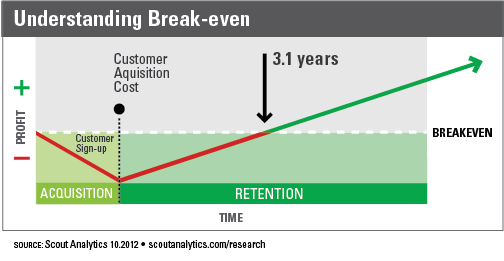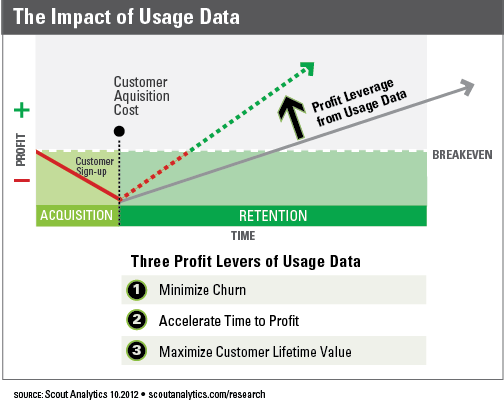The secret to profitability can be found through usage data. By “usage data” we mean data concerning customers’ usage of a subscription service. This metric is the basis for designing rate plans and billing usage charges. For example, if you look at your own mobile plan, the charges based on data, call time, and texting are prime examples of usage data. More specifically, they are all examples of metering, reporting and invoicing usage.
In the Subscription Economy, massive volumes of usage data are generated daily for a service provider. This usage data captures utilization of features, content consumption and more at a user, contract and customer level. The companies that connect usage data to critical decisions in customer success, product management, marketing and sales are the ones achieving profitability.
Since revenue and profits are deferred in the Subscription Economy, customer acquisition is only the first step toward a profitable customer relationship. For example, last week’s post showed that current benchmarks in the software as- a-service (SaaS) industry indicate an average of three-point-one years for a customer relationship to reach profitability.

Consequently, the three goals for increasing profits in a subscription-based revenue model are:
- Minimizing churn
- Minimizing time to customer profit
- Maximizing customer lifetime value
So how does usage data affect these goals?

Minimizing Churn
Usage data is the best indicator of whether a customer is receiving value from their subscription. And when customers receive good value, they don’t churn. In the hands of customer success managers, usage data quickly segments customers into those who are receiving good value and those that are not. Unlike surveys that cover a fraction of the customer base, usage data is available for each and every customer. When combined with the survey results like Net Promoter® scores, usage data can identify retention risks based on customer behavior. Usage data gives customer success managers insights into revenue retention opportunities that would have otherwise been missed.
Minimizing Time to Profit
As illustrated in last week’s post, most customer relationships take two to three years to become profitable to service providers. Usage data shortens that time to profitability by enabling product management to design rate plans that match customer usage patterns. Rate plans often fail to capture ten to fifteen percent of revenue that satisfied customers would have paid because pricing and packaging was done without usage data. Usage data informs the product manager what features or content should be bundled or unbundled from a particular rate plan. Additionally, usage data can be used to make decisions about tiering of rate plans. Targeting rate plan prices based on customer segmentation such as industry can also be discovered by harnessing usage data to find your top users. Accurately packaging, tiering and targeting rate plans based on customer usage increases the revenue yield from your product catalog and shortens time to profitability.
Maximizing Lifetime Value
Usage data is the best lens through which to increase customer lifetime value. Knowing what marketing promotions to run, what cross-selling strategies to use and whom to target with rate plans changes are all products of harnessing usage data. At renewal, the customers in the top ten percent of usage of a base package are the best prospects for the professional package. Knowing who they are is as simple as tapping into the usage data. Likewise, customers in the bottom ten percent of usage are the ones least likely to accept an annual rate plan increase. However, when utilizing usage data, these customers can be easily contacted and targeted with a different rate plan. When a new product is launched, creating incentive for your best customers to become early adopters can be done by creating promotions and targeting them based on usage data.






